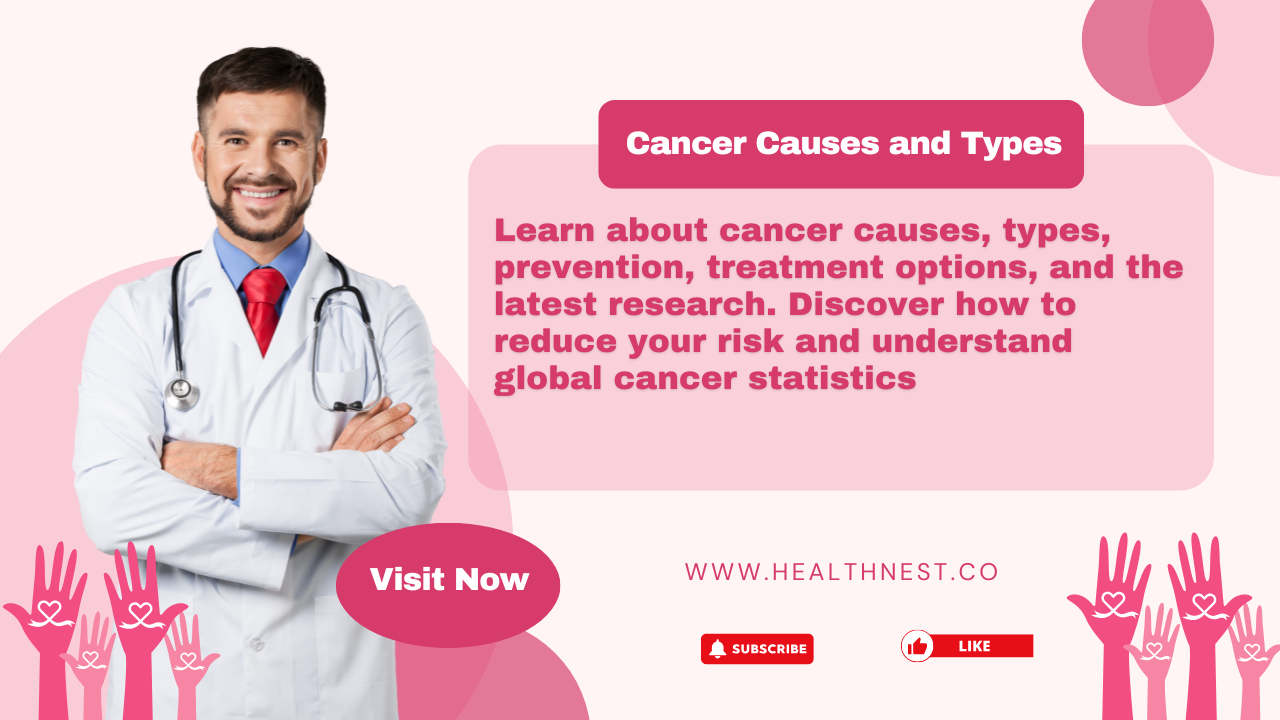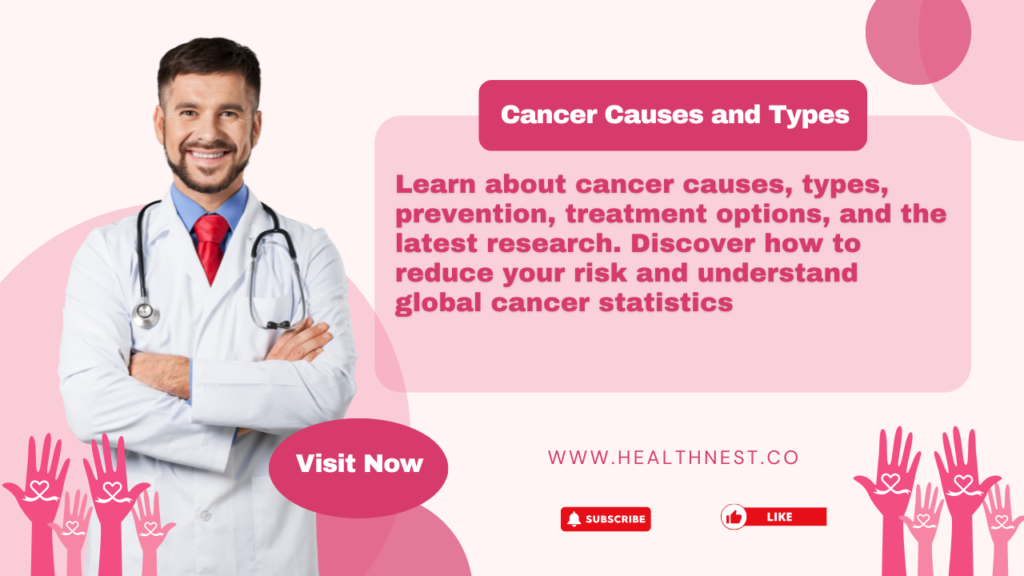How to Understand Cancer Causes and Types

Cancer exists as one of the most difficult diseases which currently plagues humanity. A group of diseases exists when abnormal cells expand out of control leading to their unregulated spread in medical terms. Unaddressed cancer growth spreads to vital tissues until degeneration causes fatal complications which eventually result in mortality. WHO reports that cancer positions as the second biggest cause of global fatalities because it killed 10 million people during 2020. The disease has proven devastating yet researchers achieved notable advancement regarding its comprehension along with enhancing the identification of early symptoms and pioneering new treatment methods. This text analyzes cancer in detail through an investigation of its foundation causes alongside its various forms and prevention techniques and treatment methods alongside recent developments in cancer scientific research.
Understanding Cancer: What Causes It?

Genetic mutations which disrupt normal cell growth control systems produce cancer in human bodies. The development of cancer starts from mutations that persons either acquire through inherited characteristics or develop through exposure to carcinogens. Multiple carcinogens which include tobacco smoke and both ultraviolet (UV) radiation and chemical elements in addition to human papillomavirus (HPV) and hepatitis B virus (HBV) contribute to cancer development. The risk of cancer development increases when people eat poorly while being sedentary and drink alcohol heavily. Cancer development risk becomes higher as people advance in age mainly due to genetic damage building up through time.
The medical term for cancer development is called carcinogenesis which requires different sequential steps. A genetic mutation transforms an ordinary cell into an initiated one during this initial phase. During the promotion stage the abnormal cell division of the mutated cell takes place. During the progression phase cancer cells gather further mutations which allow them to spread into neighboring tissues while migrating to other organs in the body.
Types of Cancer: A Diverse Spectrum of Diseases
Multiple diseases are incorporated under the term cancer because this group of related conditions manifests within various body sections. Among all cancers breast cancer together with lung cancer and prostate cancer and colorectal cancer and skin cancer stand out as the most prevalent forms. Every cancer subgroup exhibits specific traits alongside its own susceptibility variables as well as its own therapeutic methods. The breast cancer disease primarily occurs within female bodies and connects with hormone regulation yet lung cancer strongly stems from tobacco usage and environmental contaminants.
Medicine divides cancers into solid tumors together with hematologic cancers. Solid tumors create tissue masses that form within the breast alongside other body regions such as the lung and colon. The blood along with bone marrow and lymphatic system comprise the target areas of hematologic cancers. The disease category comprises three major types of cancer which include leukemia, lymphoma as well as myeloma. The correct cancer classification enables healthcare providers to select fitting treatment methods because each cancer type reacts differently to treatment approaches.
The Global Burden of Cancer
Millions of fresh cancer cases develop annually because cancer puts an enormous weight on communities worldwide. Research from the International Agency for Research on Cancer (IARC) demonstrates that cancer produced 19.3 million new cases while causing 10 million fatalities in 2020. Among all cancer diagnoses globally the most frequent occurrences include breast cancers followed by lung cancers then colorectal cancers after that prostate cancers and stomach cancers. Low- and middle-income countries (LMICs) face an elevated ratio of cancer events and fatalities compared to other regions of the world. These regions face a major issue because they lack proper early detection, diagnosis and treatment services.
The health care sector sustains substantial financial losses because of cancer. Cancer treatment costs consist of clinical fees for medical procedures combined with second-hand costs which stem from work-related losses and lifestyle deterioration. Cancer creates a large financial load which strongly affects patients alongside their families principally within limited-resource areas. Multiple interventions are needed to handle the worldwide cancer crisis by strengthening research funding and raising public health measures and expanding cost-effective cancer treatment availability.
Prevention: Reducing the Risk of Cancer
A large number of cancer occurrences are preventable based on the implementation of effective prevention strategies even though complete prevention is not possible for every cancer type. WHO scientists state that modifying risk factors could reduce the occurrence of 30-50% of cancer cases. People should stop using tobacco products while watching their diet and weight and participating in exercise frequently and minimize their alcohol intake together with protecting themselves from dangerous UV radiation.
Medical professionals have found vaccines to serve as one of the most effective methods for stopping cancer development. Medical research demonstrates that HPV along with HBV vaccine protection produces significant reduction in cancer development patterns in the cervix and liver tissues. Screening programs represent a vital tool because they detect cancer at its earliest stages which are more treatable as well as prevent cancer. Professional tests such as mammograms for detecting breast cancer and Pap tests for cervical cancer screening and colonoscopies for colorectal cancer continue to be standard procedures in medical practice.
Diagnosis and Staging: The First Steps in Cancer Care
Diagnosis precision along with staging of cancer plays an essential role in designing treatment plans that prove effective for patients dealing with cancer. Doctors initiate diagnosis through physical assessments of patients in combination with reviews of their healthcare records. The evaluation of tumors through X-rays and computed tomography (CT) scans and magnetic resonance imaging (MRI) checks tumor size and location. The analysis of tissue samples with microscopic examination through biopsies helps both confirm cancer existence along with identifying its specific type.
The extent of the disease becomes clear through staging following cancer diagnosis. During staging healthcare providers evaluate tumor dimensions in addition to checking if cancer cells reached nearby lymph nodes or spread throughout the body. Medical professionals primarily utilize TNM staging which uses Tumor, Node and Metastasis classification. Medical professionals use staging to forecast disease progression therefore selecting the suitable therapeutic methods.
Treatment Options: A Multidisciplinary Approach
Modern cancer treatment approaches each therapy to an individual patient while utilizing multiple treatment types. Treatment selection happens according to cancer type and stage combined with patient health condition and personal treatment preferences. Patients with cancer receive their main treatments through surgery combined with radiation therapy together with chemotherapy and immunotherapy and targeted therapy and hormone therapy.
Patients who have solid tumors usually begin their medical treatment with surgical intervention. The treatment process consists of tumor removal together with optional extraction of surrounding lymph nodes or adjacent tissues. The administration of drugs functionally targets cancer cells to destroy them and halt their division. The effectiveness of chemotherapy leads to side effects affecting healthy cells which results in fatigue and nausea alongside hair loss.
The medical success of treating specific cancer types now depends on immune checkpoint inhibitors and CAR-T cell therapy applications within immunotherapy medicine. The treatment of hormone-sensitive cancers through breast and prostate cancer involves hormone therapy officials to prevent hormone production or hormonal responses in the body.
The Role of Supportive Care and Survivorship
Medical treatment for cancer creates difficult physical and emotional hardships that supportive care helps patients manage through side effect treatment while improving their quality of life. Executives of supportive care provide pain management combined with nutritional support together with psychological counseling and rehabilitation services. Palliative care stands as an important cancer care framework that specifically helps advanced disease patients by providing symptom relief and comfort improvement.
Better medical treatments lead to expanded cancer survivor rates compared to previous periods. Cancer survivors experience multiple persisting physical complications together with emotional problems along with economic obstacles. Nurses in survivorship programs address issues through medical attention, recurrence surveillance and supportive services to assist survivors with regular life readaption.




Hola, volia saber el seu preu.